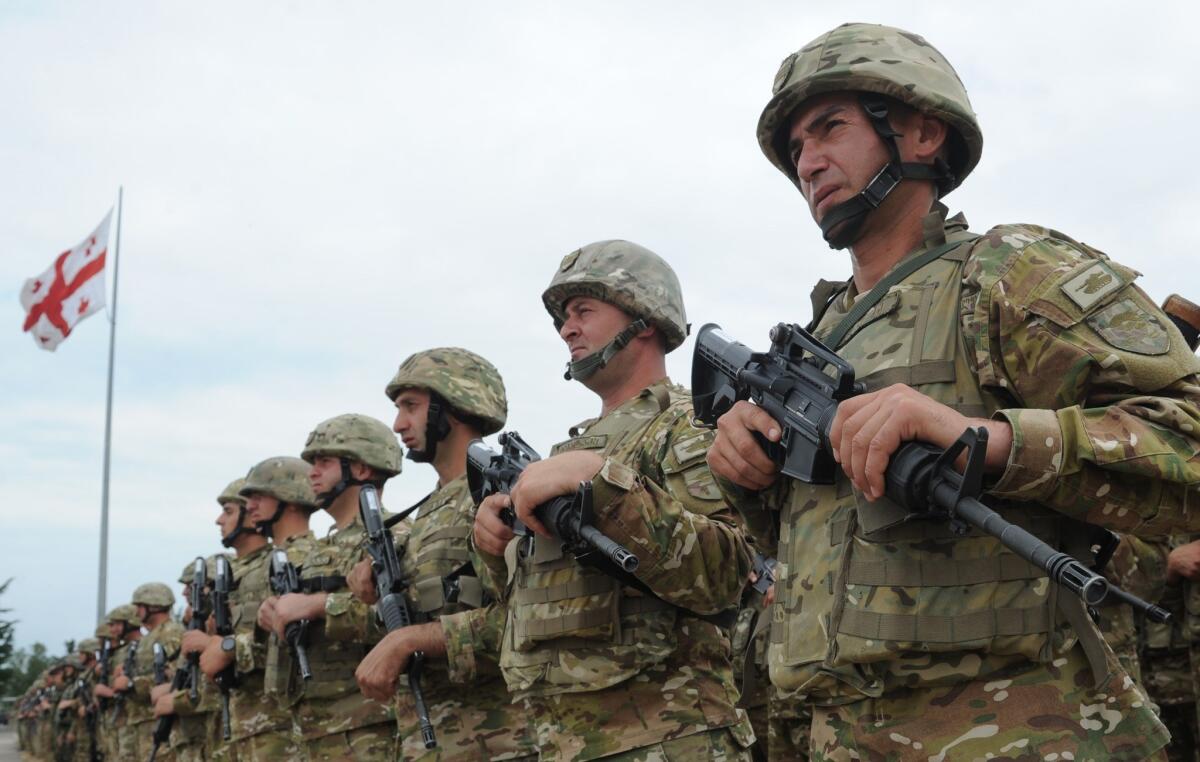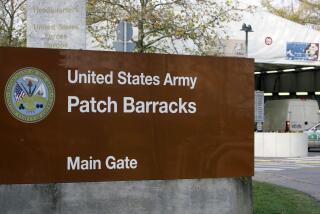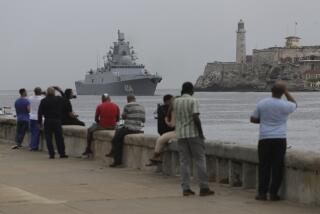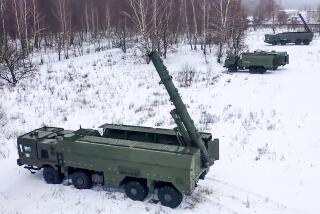NATO and Russian war games could spur real conflict, analysts warn

Soldiers from the former Soviet republic of Georgia trained with NATO forces in the Agile Spirit 2015 military exercise at a base outside Tbilisi, the Georgian capital, in July.
Russia and NATO have been staging military exercises designed to confront a threat from the other, raising the danger of an accidental collision or misunderstanding that could provoke actual war, European security analysts warn.
Russia and the Western military alliance have increased the scope and frequency of war games and have conducted many in the sensitive border areas where they are seen as provocation, the London-based European Leadership Network concludes in a report made public Wednesday: “Preparing for the Worst: Are Russian and NATO Military Exercises Making War in Europe more Likely?”
The security think tank’s conclusion appears to be that the tailored exercises by the Kremlin and the North Atlantic Treaty Organization are intended to send adversaries a message of resolve that also dangerously elevates the risk of instigating the confrontation for which they are designed.
“Each side is training with the other side’s capabilities and most likely war plans in mind,” warns the report written by three veteran analysts of arms control, nuclear deterrence and the security policies of Russian and Western governments.
The exercises are said to be targeted at “hypothetical opponents,” the researchers noted, but “the nature and scale of them indicate otherwise: Russia is preparing for conflict with NATO, and NATO is preparing for a possible confrontation with Russia.”
The report points to two massive exercises staged this year that illustrate how practicing for war has aggravated tension and elevated a dangerous atmosphere of unpredictability.
In March, Russia staged snap air and sea drills centered on its Northern Fleet that brought together 80,000 military personnel, more than 100 combat aircraft and 80 warships to the Barents Sea. An overlapping land exercise in the western and central military districts involved an additional 70,000 troops, 880 tanks and 1,200 pieces of artillery and armored transports.
NATO, during its Allied Shield exercise in June, deployed 15,000 troops from 19 member countries and three partner states along the alliance’s eastern flank -- action perceived in the Kremlin as aggressive and an attempt by NATO to provoke internal unrest.
Both sides have announced intentions to stage further exercises this year with drastically increased frequency.
NATO’s supreme commander for transformation, Gen. Jean-Paul Palomeros, said at a news conference in Brussels in May that 270 exercises were planned this year, with about half of them devoted to reassuring Eastern European members that the alliance will protect them in the case of Russian aggression.
The Russian Defense Ministry has disclosed plans for 4,000 military exercises in 2015, although that reportedly includes many smaller-scale maneuvers.
The frequent flexing of military muscle, especially in tense border regions, carries “increased risk of the dangerous military encounters between Russian and Western military units of the sort documented by the European Leadership Network in November 2014,” the scholars warned. The network reported more than 100 incidents of aircraft and ships violating airspace or maritime borders, or coming dangerously close to a collision.
The report made four recommendations to defuse the mounting tension threatening conflict: better communication between NATO and Russian officials to alert the other side to impending war games; use of the monitoring services and confidence-building practices of the Organization for Security and Cooperation in Europe, which includes Russia and NATO member states; political evaluation of the pros and cons of intensified military activity in border areas; and work toward a new conventional arms control treaty.
A NATO spokeswoman responded to the think tank report with a defense of the alliance’s readiness drills, saying they are “proportionate, defensive and fully in line with our international commitments.” Spokeswoman Carmen Romero complained that the scholars’ analysis “misleadingly puts NATO and Russian exercises on par,” a claim that European Leadership Network Director Ian Kearns denied.
NATO has tried to build a cooperative relationship with Russia over the last two decades, Romero said. “But Russia has changed borders by force, continues to support separatists in Ukraine and threatens to base nuclear missiles close to alliance borders.”
The Russian government made no immediate comment on the report, nor did the official Tass news agency. The Sputnik news site, heavily state-influenced as most Russian media are, reported NATO’s “blast” at the think tank’s analysis. It also responded to the analysts’ call for better communication between the two forces by noting that it was NATO that suspended regular meetings of the NATO-Russia Council in June 2014. Sputnik omitted mention of the action that prompted the halt in contacts: Russia’s March 2014 invasion and annexation of Ukraine’s Crimea area.
Follow @cjwilliamslat on Twitter for the latest international news 24/7.
More to Read
Sign up for Essential California
The most important California stories and recommendations in your inbox every morning.
You may occasionally receive promotional content from the Los Angeles Times.











